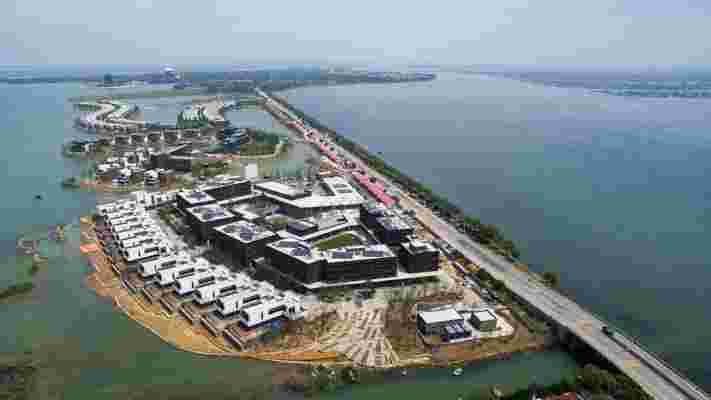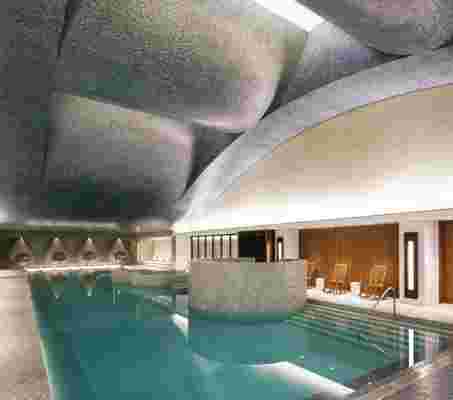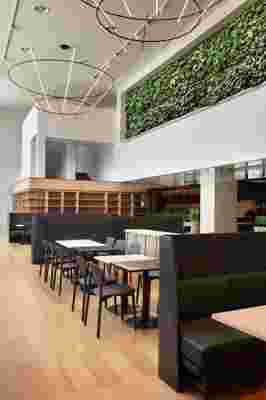Roughly an hour’s drive west of Shanghai—just decades ago a landscape of rice paddies—a new project by New York’s Tsao & McKown Architects brings a new scope for residential development on the periphery of Suzhou.
In collaboration with the Shanghai-based developer Octave, Tsao & McKown’s Sangha is a holistic response to Shanghai’s rapid expansion into the historic canal city of Suzhou. Which isn’t to suggest that the development is any less ambitious: Cultivating 46 acres across Yangcheng Lake, Sangha comprises a mix of single-family homes, serviced apartments, two hotels, a wellness center, a medical clinic, a food hall, a conference and learning center, and, most uniquely, a spate of community- and childhood-focused programs.

Stretching across Yangcheng Lake on the fringe of Suzhou, a UNESCO World Heritage Site known for ancient canals, Sangha is a collaboration between New York’s Tsao & McKown and Shanghai’s Octave—along with support from the Chinese government and various socially driven entities—to create a new and nourishing model for urbanizing landscapes.
But unlike the outsourced and outsize government-enforced methods that modernized China’s economy in the past, here is a viable master plan with a social backbone; in one setting, the dynamic revolves around a mantra Tsao & McKown (which served not only as lead architect but also creative director) calls a “live-work-learn” community, where man-made structures are human-scaled, sensitive to nature, and nourished by work and culture.
Sangha consciously links Shanghai and Suzhou without overwhelming the latter’s lower-level, heritage-based fabric—it achieves metropolitan life within, yet outside the lines of urbanization.

Take Sangha’s wellness center, which embodies Tsao & McKown’s overall mission of commercial and cultural balance: Treatments are customizable and wholly embrace both Eastern and Western philosophies, eschewing the one-size-fits-all approach to health. Linked with At One Clinic, the community’s medical center, both facilities champion anything from nutritionists to traditional Chinese medicine and life coaches.
“We determined that the best way to drive human impact through design was by layering unique programs: Medical clinics link wellness centers; art galleries are located around children’s education rooms; ADA-accessible ramps lead directly to public plazas for all,” says Calvin Tsao, the principal and cofounder of Tsao & McKown alongside Zack McKown. “It’s a place, not a product.”
And while it’s composed for both commercial gain and cultural wellness, it’s still a viable model that Tsao & McKown hopes other emerging cities will adopt. “What is unique is the holistic ecosystem of programming—and, from an operations perspective, it functions and makes money!” says Tsao. Go ahead: Call it structural integrity.

The 25,000-square-foot food hall draws a deeper connection to nourishment, bringing both local and global cuisine to the table while opening up the kitchen. Cooking classes, and even excursions to organic farms, round out the interactive programming.
Beyond surface-deep, textures recall heritage from Suzhou’s past. “Local creatives and craftspeople are critical,” says Tsao. “We believe that it’s an architect’s responsibility to support crafts and artisans, which are part of human heritage.” You’ll spot linens sourced from nearby textile markets and local stone set by local masons. In order to illuminate one disappearing craft, chandeliers incorporate oil-paper umbrellas into the fold—instead of going against the grain, details find comfort in local roots.
A balance of larger townhouses, single-family homes, and optimized apartments accommodate growing, aging, and multigenerational families alike, expressing wellness through natural palettes while buildings orient toward sunshine and cool air.
Otherwise neglected by local municipalities in the past, Sangha activates an organic approach to space. “The government is recognizing the value of Chinese planning and cultural principles that are unique to this ancient, diverse country, such as courtyard typologies, ideas of enclosure and privacy, and certain approaches to mixed-use sites,” explains Tsao. Streets and pathways are all intimately scaled to a pedestrian’s stride; the complex flows naturally along water, gardens, and unifying courtyards, altogether building a sense of community with the environment.
Opting for human-scaled buildings over skyscrapers, Tsao & McKown went deeper by way of earth berms which, while deep underground, help cool the interiors while allowing windows to bring sunlight into each structure—nature isn’t covered up, as the building itself is embedded in the earth.
Tsao stresses that principled design, not style, achieved a sense of wellness. “Sangha feels great to people because they are often near the outdoors but protected from the elements. They can move freely and easily among spaces that are scaled to the human body. They aren’t overwhelmed by decor so that they can focus on themselves and how they feel in a place and among people. The services and programs actually function and have a reason to be there. Sangha works, so it feels good and has an impact.”
RELATED: The Design of Cities in the Year 2039
